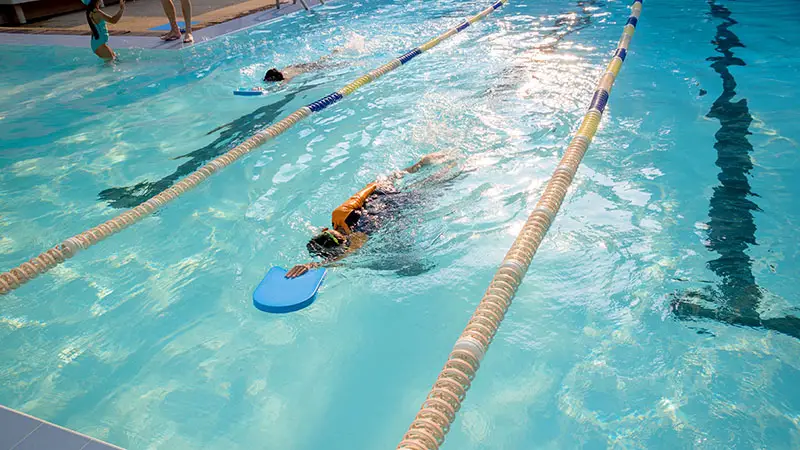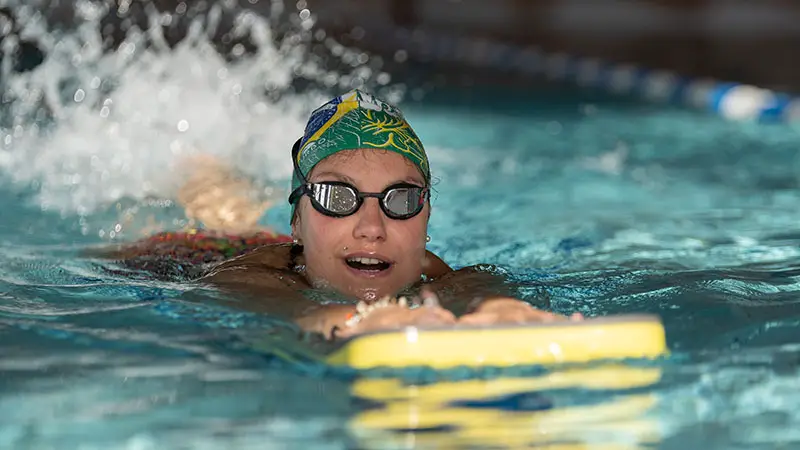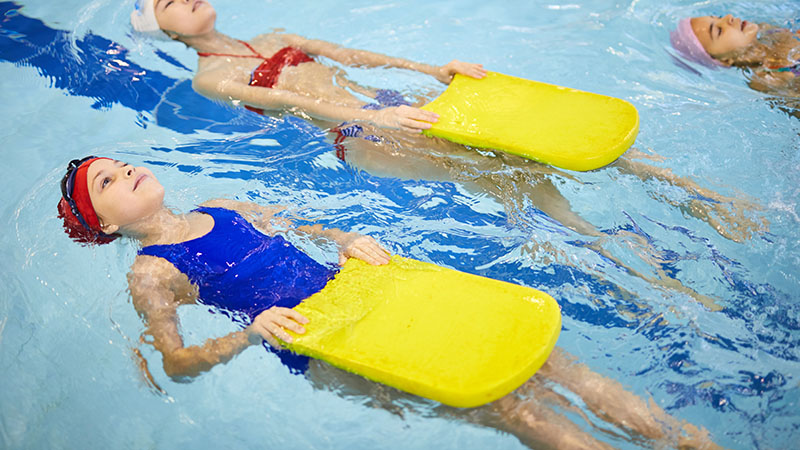Contents
Swimming is an amazing full body exercise. It’s a great way to burn some calories without adding extra strain on your joints, and you can do it any time of year if you have access to an indoor pool! But what if you want a change of pace? Maybe you love swimming, but your arms are sore. Or maybe you want to take it easy or work on your form?
Well, some swimmers enjoy mixing things up by incorporating a kickboard with some of their swim workouts. Essentially, a kickboard is a flat flotation device that allows your upper body to be supported while your lower body takes on most of the work. There are many ways to use a kickboard and even some ways you should avoid.
First, Why Use a Kickboard?

Before we dive into how to use a kickboard for swimming, let’s take a deeper look at why swimmers will use them.
More Stable
Essentially, a kickboard is a floatation device, which means it can allow your body to stabilize while swimming. If you’re not as confident with your swimming abilities or simply want to focus less on the whole staying afloat thing and more on getting in an intense workout, then the kickboard is perfect. It stabilizes your body and allows you to focus more on the other aspects of swimming.
Focuses on your legs
Kickboards are not only great to add stability, they also allow swimmers to focus on their lower body. As I mentioned above, swimming is a full-body workout, which is great! However, if you are suffering from a shoulder injury or upper body injury and you still want to get a good workout in, the kickboard is perfect. It allows you to bring more versatility into your swimming routine.
Improves Kicking Skills
While the kickboard is allowing you to focus on your lower body in terms of strength and endurance, it’s also a great way to work on your swimming technique and kicking skills. Even the most proficient swimmers can always use some practice perfecting their craft, and the kickboard allows this to happen.
Easier to Breathe
Swimming is the only form of cardio in which our breathing is limited. Think about it like going for a run, but only being able to breathe every few seconds! That can be incredibly draining, especially because swimming can be such an effective and tiring workout!
The great thing about using a kickboard is that you don’t have to work on alternating your breath. Because you can be stable with your head above the water, you can focus more on your swimming, form, and movements and less on having to control your breathing!
How To Use a Kickboard for Swimming
- Grab front of kickboard with both hands
The first step in how to use a kickboard for swimming is to position yourself correctly. First, you want to grab the front of the kickboard with both hands, preferably having them spread out about shoulder width apart. Make sure your elbows rest on the kickboard to ensure proper position!
- Straighten back and lift legs
This next step is where most people can go wrong when learning how to use a kickboard for swimming! You need to tighten your core, straighten your back flat, and have your legs lifted almost parallel to your body. You want to be as flat as possible to ensure proper form.
- Work on proper kicking technique
Once you have your body in position, kick and flutter your legs. Because you are using a kickboard, your legs are your only source of propelling. I’ll mention this later, but make sure that you are using your entire leg and not just your calves or you could encounter some discomfort!
- Breathwork variation
As mentioned in why people use kickboards, it gives you the opportunity to work on your swimming without the complication of breathwork. However, if you want to work on your breathwork, you can easily do this with a kickboard as well! Instead of holding on to the top of the kickboard, you can hold on to the bottom, giving more space to work on timing your breath with your strokes without having to incorporate the arm movements.
How To Use a Kickboard Successfully In Your Training

There are lots of ways to use a kickboard to help with your training. The easiest way to use them is by doing your normal routine, just focusing on your legs and kicks. But, there are also some more unique ideas on how to use a kickboard successfully to help you in your fitness journey.
Use a Board and Snorkel
You can use a kickboard without going under water, and you can use them by going underwater as well, but if you want the best of both worlds, you can use a snorkel while using your board. By doing this, you can focus on all of your typical swimming movements, just without your arm work.
Mix Up How You Are Kicking
Another way you can use a kickboard to help with your training is by mixing up how you are kicking. As long as you are keeping yourself horizontal with your back straight, you can work on your different strokes, like the flutter kick or your breaststroke kick.
Think Outside the Box
You can use your kickboard for more than just kicking drills. As I mentioned above, you can use them with your everyday workout, HIIT drills, or anything else you would typically do in the pool. You will just focus on your legs and give your arms a rest. Just get creative and think outside of the box because your kickboard is incredibly versatile.
Less Known Kickboard Exercises

As mentioned earlier, there are lots of ways you can use a kickboard while swimming, and here are two more lesser known exercises you could try!
Work on Backstroke
Termed “hugging your kickboard” because that’s what you do during this workout! Lie flat on your back like you are floating and hug your kickboard to your chest with your arms crossing over it. From there, you can work on your backstroke kicks!
“L” Sits
“L” sits are more of an exercise and less of a swimming style. With this move, you have your chest on your kickboard and your legs below in the water. Your body should make an “L” shape. From there, you use your hip flexors and abs to swing your legs backwards to get your legs to reach the top of the water before returning to the “L” shape.
Common Mistakes When Using a Kickboard
Kick boarding can help lower the intensity of your swimming workout or increase the intensity of focus on your lower body depending on your desired results. As with any exercise, if you don’t do them properly, you can experience injuries or discomfort. Here are the two biggest mistakes when using a kickboard for swimming that you’d want to avoid…
- Posture and Positioning
Your posture is key when using a kickboard for swimming. If you do not maintain a straight back and an engaged core, you could risk neck strain because of the positioning of your body. Likewise, you can cause shoulder and upper arm discomfort if you do not hold on to the board properly and make sure that your elbows are resting on the kickboard.
- Incorrect Kicking
Another common mistake made when using a kickboard is kicking just with the calves instead of the entire leg. Some of this may be because of poor positioning, but as you are using the kickboard, be sure to kick strongly with all of your leg muscles.
Kickboard Limitations

Now that you understand how to use a kickboard for swimming and everything else in between, it’s important to know that it has its limitations. While they are great for people with some injuries, you definitely need to consult with your doctor before trying any new form of workout. Below are just a few of the limitations, and it is definitely not a comprehensive list.
No Hip Rolls
With kickboards, they often limit swimmers’ mobility with the ability to roll their hips. This is pretty important for some strokes and general swimming.
Neck Issues
As referenced above, if your posture isn’t exactly on point, kickboards can cause some undue strain on your neck. So, if you have a past with neck issues, approach with caution, or at least make sure you fully understand how to use a kickboard for swimming properly before diving in.
Shoulder Issues
Similarly to neck issues, some people with past shoulder issues may experience some discomfort. Even though kickboards don’t use the arm movements of swimming, the arms are still engaged and if the positioning isn’t right, it could act as an irritant for your shoulders.
Conclusion
Kickboards can be a useful tool to include in your swim training. Above, we cover why you would use a kickboard in the first place. In addition, we also cover exactly how to use a kickboard for swimming to be successful, less known kickboard exercises, and common mistakes when using a kickboard. Now go get in the water and start kicking!

